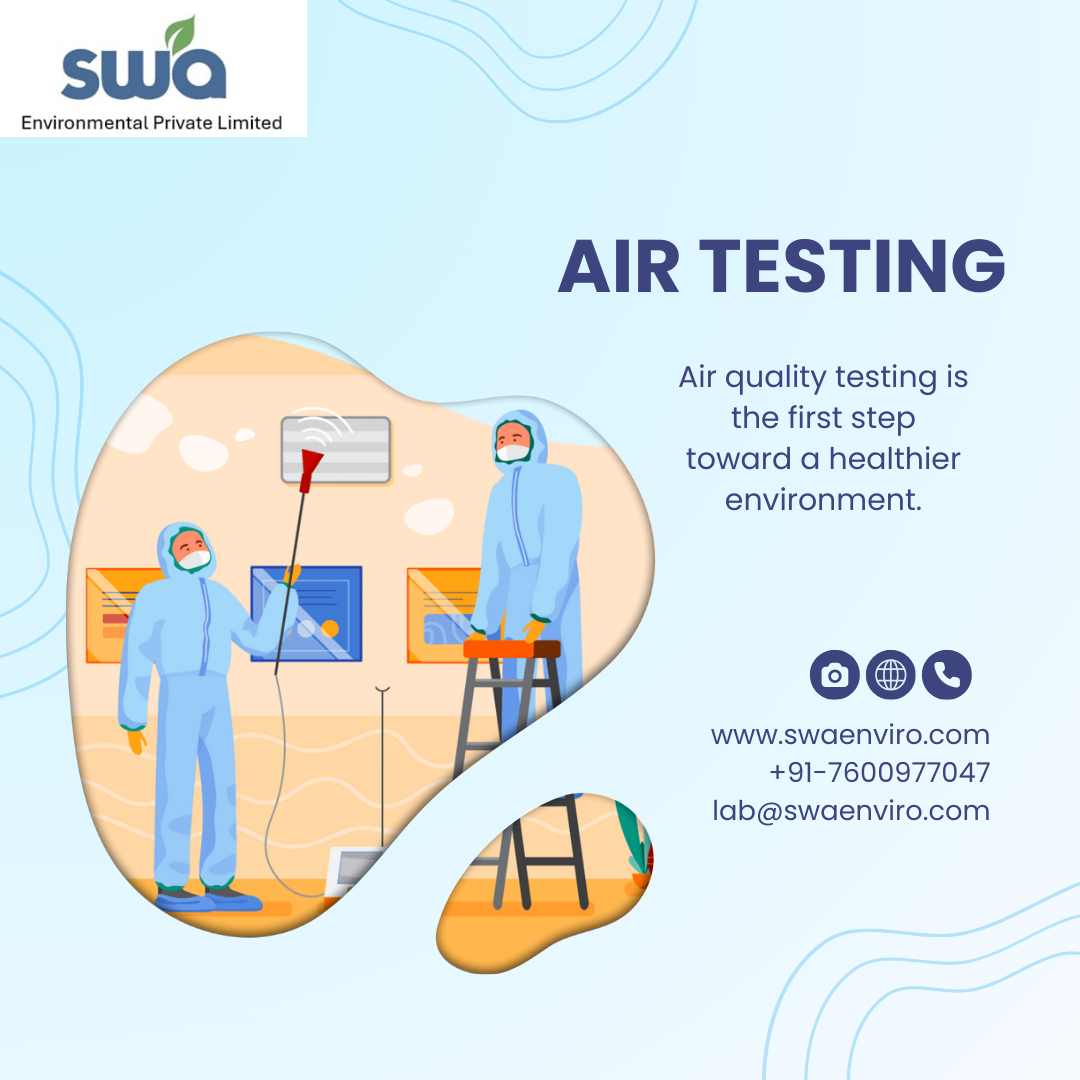(Editor-Pankaj Gothi)
SWA Environmental Pvt. Ltd., a leading Ambient air quality, Stack emission air quality testing and monitoring service provider in Gujarat, India, is known for its high-quality services and skilled professionals, offering pan-India coverage with its head office based in Ahmedabad, Gujarat. Air, the essential mixture of gases that sustains life on Earth, consists mainly of nitrogen (78%) and oxygen (21%), along with small amounts of gases like carbon dioxide and water vapor. However, air quality can be compromised by pollutants, impacting both human health and the environment.
Air testing is a critical process used to evaluate the quality of the air we breathe. By analysing air samples, we can detect and measure the presence of pollutants, allergens, and harmful chemicals that may impact health and the environment. This testing helps ensure that the air meets safety standards, providing a clearer understanding of potential risks and enabling effective measures to protect public health and maintain environmental quality. Whether for industrial compliance, health assessments, or environmental protection, air testing plays a vital role in safeguarding our well-being and ensuring a cleaner, healthier atmosphere.
Air testing is a crucial process that involves analysing air samples to detect pollutants, allergens, and harmful chemicals. These pollutants include particulate matter (PM), nitrogen oxides (NOx), sulfur dioxide (SO2), carbon monoxide (CO), volatile organic compounds (VOCs), and ozone (O3). The aim is to ensure that the air we breathe meets safety standards and is free from substances that could cause harm to human health or the environment.
Air testing is like checking to make sure your favourite playground is clean and safe to play in. Just as you wouldn’t want to play in a dirty or unsafe playground, you wouldn’t want to breathe air that might make you sick. Sometimes, the air can have bad things in it, like pollution or chemicals, which can be harmful.
- Impacts of Ambient Air Quality on Human Health
Ambient air quality plays a significant role in determining public health. Poor air quality, caused by pollutants such as particulate matter (PM), nitrogen oxides (NOx), sulfur dioxide (SO2), carbon monoxide (CO), and ozone (O3), can lead to a range of short-term and long-term health problems. Below are key impacts of ambient air quality on human health;
- Particulate Matter (PM2.5 and PM10) consists of tiny particles that can penetrate the lungs and enter the bloodstream. PM2.5, with a diameter of 2.5 micrometers or smaller, is particularly concerning as it can lead to cardiovascular diseases, respiratory disorders, and increased mortality rates. Research indicates that long-term exposure to PM2.5 is associated with systemic inflammation and oxidative stress, contributing to chronic health conditions.
- Nitrogen Dioxide (NO2) is produced from vehicle emissions and industrial processes. It can cause respiratory infections, decrease lung function, and exacerbate asthma symptoms. NO2 is a precursor to secondary pollutants like ozone, and its exposure can impair the immune response in the respiratory tract, increasing susceptibility to infections.
- Sulfur Dioxide (SO2) is emitted from burning fossil fuels and can cause respiratory irritation and exacerbate asthma. When SO2 reacts with atmospheric moisture, it forms sulfuric acid, contributing to acid rain, which impacts both human health and the environment by degrading air quality and harming ecosystems.
- Ozone (O3) at ground level is formed by the reaction of sunlight with NOx and volatile organic compounds (VOCs). Exposure to ground-level ozone can lead to decreased lung function and increased asthma attacks. Ozone exposure also causes inflammation in the airways, contributing to respiratory issues and making individuals more susceptible to infections.
- Carbon Monoxide (CO) is a colorless, odorless gas produced by incomplete combustion of fossil fuels. CO binds to hemoglobin in the blood, reducing its oxygen-carrying capacity. This can lead to symptoms such as headaches and dizziness, and at high levels, it can be fatal. Chronic exposure can result in cardiovascular effects and neurological impairment.
- Volatile Organic Compounds (VOCs) are emitted from various sources, including vehicle exhaust, industrial processes, and household products. Exposure to VOCs can cause respiratory irritation and long-term effects such as damage to the liver and central nervous system. VOCs also play a significant role in the formation of ground-level ozone, exacerbating air quality issues.
- Heavy Metals, such as lead and mercury, can enter the air from industrial processes and combustion of fossil fuels. These metals accumulate in the body over time, leading to neurodevelopmental effects in children and cardiovascular diseases in adults. They disrupt biological processes, including enzyme function and hormone regulation, resulting in various health problems.
Ambient Air Quality and AQI
The quality of air outdoors, known as ambient air quality, is often monitored and measured against standards set by national and international regulatory bodies. In India, the Central Pollution Control Board (CPCB) provides guidelines for ambient air quality, which include permissible limits for various pollutants. To simplify public understanding, the Air Quality Index (AQI) is used as a standard measure that indicates how clean or polluted the air is. The AQI ranges from 0 (good) to 500 (hazardous), with higher values representing worse air quality.
Significance of Air Parameters and Their Impact on Health
The levels of air pollutants can vary based on industrial activities, vehicle emissions, natural sources, and weather conditions. Key air parameters like PM2.5, PM10, NOx, SO2, and O3 have a direct impact on human health:
- PM2.5 and PM10: Includes PM10 (particles less than 10 micrometers) and PM2.5 (particles less than 2.5 micrometers). PM2.5 is particularly harmful as it can penetrate deep into the lungs and enter the bloodstream, leading to respiratory and cardiovascular diseases.
- Nitrogen Oxides (NOx): Produced from vehicle emissions and industrial processes, NOx can lead to the formation of smog and contribute to respiratory issues.
- Sulfur Dioxide (SO2): Emitted from burning fossil fuels, SO2 can cause acid rain and respiratory problems.
- Ozone (O3): While beneficial in the upper atmosphere, ground-level ozone is a harmful pollutant that can cause respiratory problems and is formed from the reaction of sunlight with NOx and VOCs.
- Carbon Monoxide (CO): A colourless, odourless gas produced by incomplete combustion of fossil fuels; CO can interfere with oxygen transport in the body.
- Volatile Organic Compounds (VOCs): Emitted from paints, solvents, and fuels, VOCs can contribute to ground-level ozone formation and have various health effects.
National Ambient Air Quality Standards 2009 for Air Pollution
National Ambient Air Quality Standards (NAAQS) are standards for air quality that are set by the Central Pollution Control Board (CPCB) that are applicable all over the country.
The NAAQS set by the CPCB are applicable to the whole country. The CPCB draws this power from the Air (Prevention and Control of Pollution) Act, 1981.
The current standards (2009) comprise 12 pollutants and their perishable limits are as below:
- Particulate Matter 10 (PM10)
- Particulate Matter 2.5 (PM2.5)
- Nitrogen Dioxide (NO2)
- Sulphur Dioxide (SO2)
- Carbon Monoxide (CO)
- Ozone (O3)
- Ammonia (NH3)
- Lead (Pb)
- Benzene
- Benzopyrene
- Arsenic
- Nickel
Table of Ambient Air Quality Standards as per National Ambient Air Quality Standards : 2009
| Concentration in Ambient Air | |||
|---|---|---|---|
| Pollutant | Time Weighted Average | Industrial, Residential, Rural and other areas | Ecologically Sensitive Area (Notified by Central Government) |
| Sulfur Dioxide | Annual / 24 hours | 50 / 80 | 20 / 80 |
| Nitrogen Dioxide | Annual / 24 hours | 40 / 80 | 30 / 80 |
| PM10 (Inhalable Particulates) | Annual / 24 hours | 60 / 100 | 60 / 100 |
| PM2.5 (Fine Particulates) | Annual / 24 hours | 40 / 60 | 40 / 60 |
| Ozone | 8 hours / 1 hour | 100 / 180 | 100 / 180 |
| Lead | Annual / 24 hours | 0.5 / 1 | 0.5 / 1 |
| Carbon Monoxide | 8 hours / 1 hour | 2 / 4 | 2 / 4 |
| Ammonia | Annual / 24 hours | 100 / 400 | 100 / 400 |
| Benzene | Annual | 5 | 5 |
| Benzo Pyrene (Particulate phase only) | Annual | 1 | 1 |
| Arsenic | Annual | 6 | 6 |
| Nickel | Annual | 20 | 20 |

